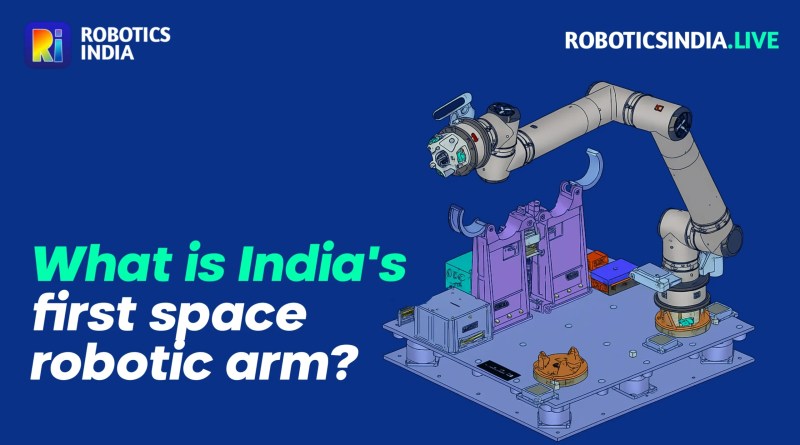What is India’s first space robotic arm?
India’s First Space Robotic Arm: The Relocatable Robotic Manipulator (RRM-TD)
Abstract
India has taken a giant leap in space robotics with the development and deployment of its first space robotic arm, the Relocatable Robotic Manipulator – Technology Demonstrator (RRM-TD), also known as the Walking Robotic Arm. Developed by the Indian Space Research Organisation (ISRO), specifically the Inertial Systems Unit (IISU) at the Vikram Sarabhai Space Centre (VSSC), this advanced robotic arm was launched onboard the PSLV-C60 mission as part of the POEM-4 platform in December 2024. The RRM-TD is a 7 Degree of Freedom (DoF) robotic arm with a unique inch-worm “walking” capability designed for in-orbit servicing, inspection, and manipulation tasks. This article delves into the technical specifications, design challenges, functionalities, and future applications of India’s pioneering space robotic arm.
Introduction
Robotic arms have become an essential component of space missions worldwide, enabling tasks ranging from satellite servicing to debris removal and planetary exploration. India’s foray into space robotics represents a strategic advancement to support future missions, including the planned Bharatiya Antariksh Station (BAS).
The RRM-TD is India’s first indigenous space robotic manipulator, pioneering several key technologies like microgravity operation, visual servoing, tele-operation, and digital twin integration. This marks a significant milestone in the nation’s capabilities in space robotics.
Background and Context
Space Robotic Arms Globally
Internationally, robotic arms like Canada’s Canadarm and Canadarm2 on the International Space Station (ISS) have demonstrated the indispensable role of robotic manipulators in space. These systems perform cargo handling, satellite repair, and debris capture.
India’s entry into this domain aims to establish a foothold for autonomous and tele-operated robotic servicing in space, reducing reliance on human extravehicular activities and enhancing mission safety and efficiency.
ISRO’s POEM-4 Mission and Robotics Payload
The POEM-4 (PS4-Orbital Experiment Module) mission utilizes the spent fourth stage of the PSLV rocket as a platform to host scientific and technology demonstration payloads in orbit for up to three months.
Among 24 payloads onboard, the RRM-TD stands out as a cutting-edge robotics experiment designed to validate key technologies critical for future missions.
Technical Description of the RRM-TD
Design and Structure
-
Degrees of Freedom (DoF): 7 DoF robotic arm allowing flexible movement and dexterity akin to a human arm.
-
Walking Mechanism: The arm relocates itself across the POEM-4 platform through an inch-worm style “walking,” gripping and releasing standardized adaptors integrated with power and data transfer capabilities.
-
Manipulator Joints: Developed indigenously with advanced robotic joint mechanisms.
-
End-Effector: Equipped with a grappling mechanism for secure attachment and manipulation.
-
Cameras: Integrated eye-in-hand camera system for visual feedback enabling visual servoing and inspection tasks.
-
Software: Advanced multi-layered software architecture supporting obstacle-aware motion planning, compliance control, and tele-operation.
-
Processor: High-performance onboard computing hardware capable of real-time complex calculations.

Capabilities Demonstrated
-
In-Orbit Mobility: Demonstration of end-on-end walking in microgravity, enabling the robotic arm to cover a large workspace.
-
Visual Servoing: Utilizing camera feedback for precise control of movements and pose estimation (6DoF).
-
Obstacle Awareness: Advanced algorithms to avoid collisions and operate safely in cluttered environments.
-
Tele-Operation and Autonomy: Support for ground control as well as autonomous functions for future mission adaptability.
-
Power and Data Grappling: Harness-free operation via special fixtures facilitating power and data transfer without cumbersome cables.
Objectives and Significance
The RRM-TD experiment serves as a precursor technology for several applications:
-
Bharatiya Antariksh Station (BAS): Future Indian space station missions will benefit from robotic servicing arms for maintenance, inspection, and cargo handling.
-
Microgravity Robotic Operations: Understanding challenges and behaviors of robotic manipulators operating in microgravity.
-
Robotic Satellite Servicing: Enabling satellite refueling, repair, or debris removal in orbit to extend satellite lifespans.
-
Vision-Based Navigation: Enhancing autonomous navigation and manipulation using onboard visual sensors.
-
Digital Twin Integration: Creating digital replicas to monitor and control the robotic arm in real-time from the ground.
Challenges Overcome
-
Microgravity Dynamics: Designing motion planning and control algorithms suitable for the absence of gravity, where every action induces reaction forces that can destabilize the platform.
-
Thermal and Radiation Effects: Developing components capable of withstanding harsh space environment conditions.
-
Real-Time Control: Ensuring low latency, high reliability, and safety in tele-operated and autonomous modes.
-
Compactness and Weight: Engineering a lightweight yet robust arm fitting stringent launch vehicle payload constraints.
-
Indigenous Development: Designing all critical components in India to ensure self-reliance in space robotics.
Read More : How ISRO is Boosting Robotics in India
Future Prospects
The success of the RRM-TD opens pathways for:
-
Advanced Space Robotics: Development of multi-robotic arm systems for cooperative tasks.
-
Robotic Maintenance Missions: Robotic servicing of satellites to mitigate space debris and extend mission lifetimes.
-
Interplanetary Missions: Deployment of robotic manipulators on lunar or planetary landers to conduct surface experiments and sample collection.
-
Integration with AI: Leveraging machine learning for autonomous decision-making and complex task execution in space.
-
Commercial and Scientific Use: Supporting private sector space activities and scientific experiments in orbit.
Conclusion
India’s first space robotic arm, the Relocatable Robotic Manipulator – Technology Demonstrator (RRM-TD), is a landmark achievement in the country’s space technology development. With its innovative walking capability, advanced control systems, and vision-based operation, the RRM-TD has demonstrated the potential for sophisticated robotic servicing in space.
This indigenous development not only enhances ISRO’s mission capabilities but also positions India as a significant player in the emerging domain of space robotics, critical for future sustainable space exploration and satellite operations.



